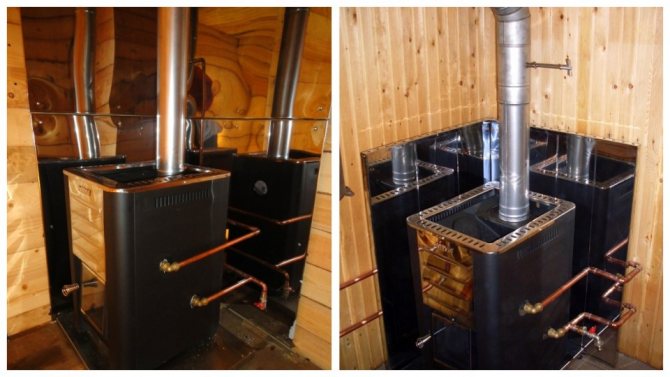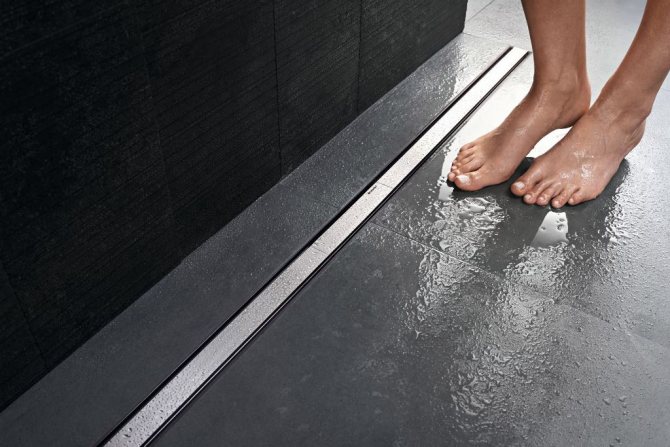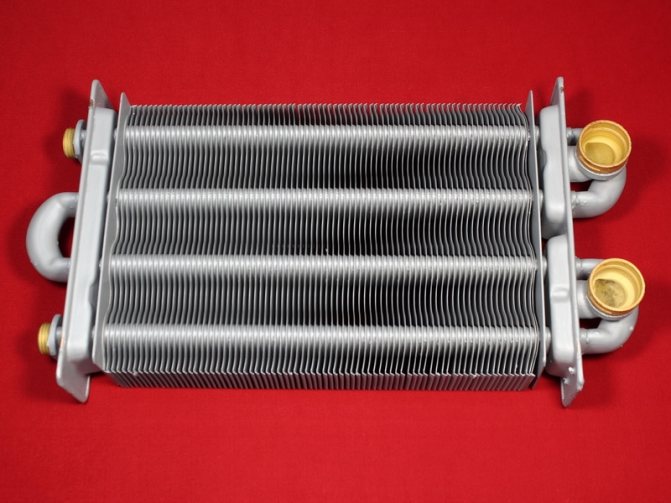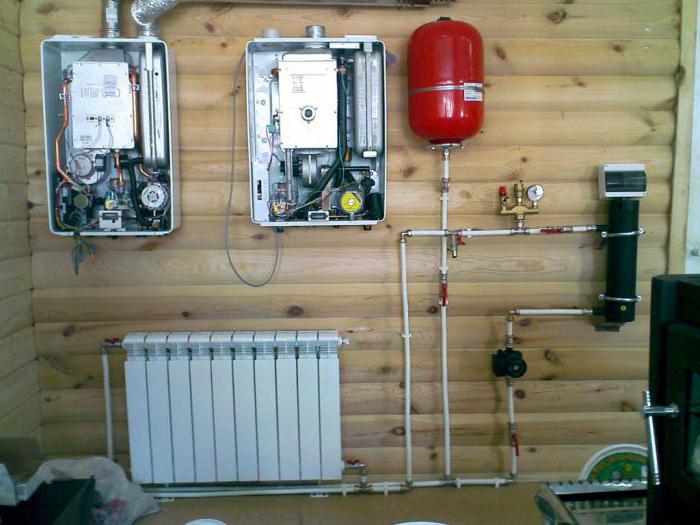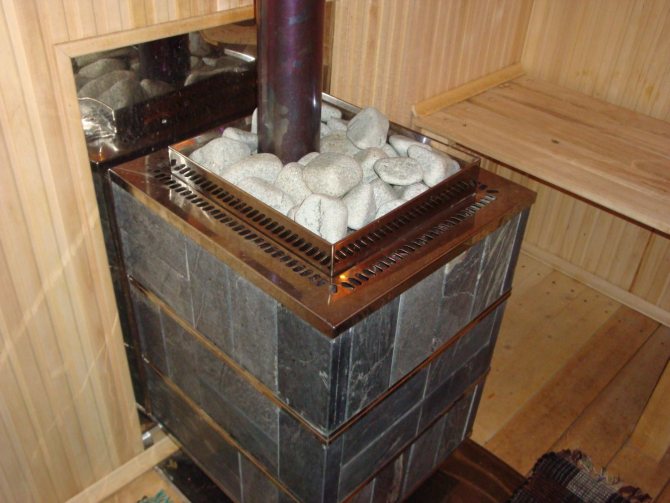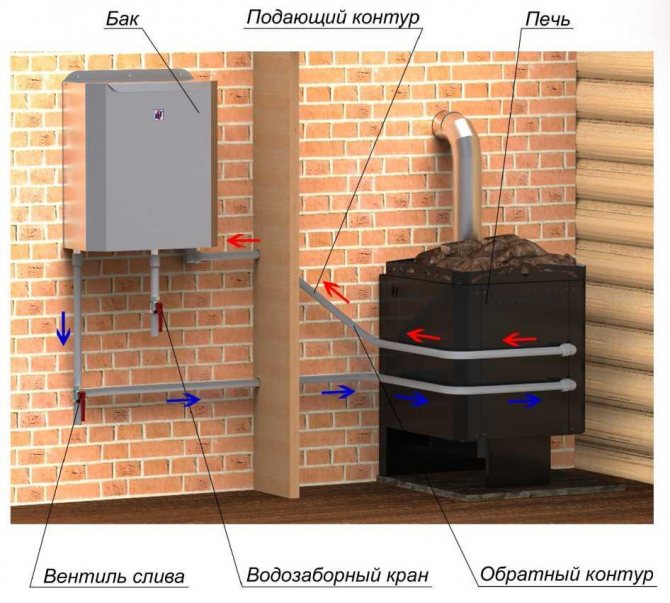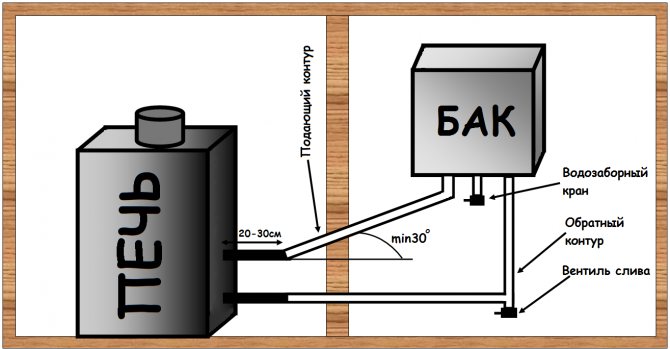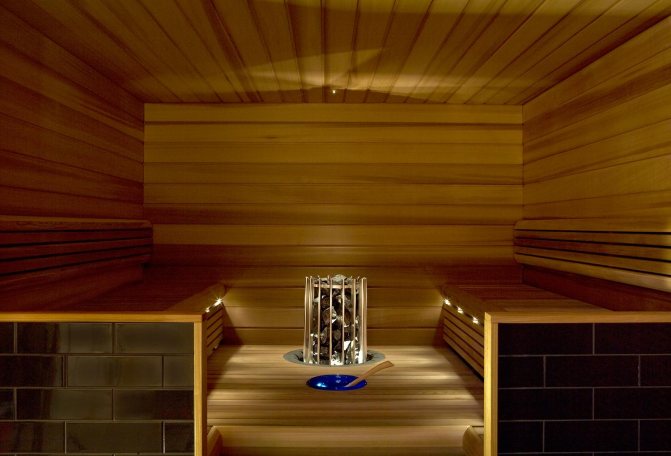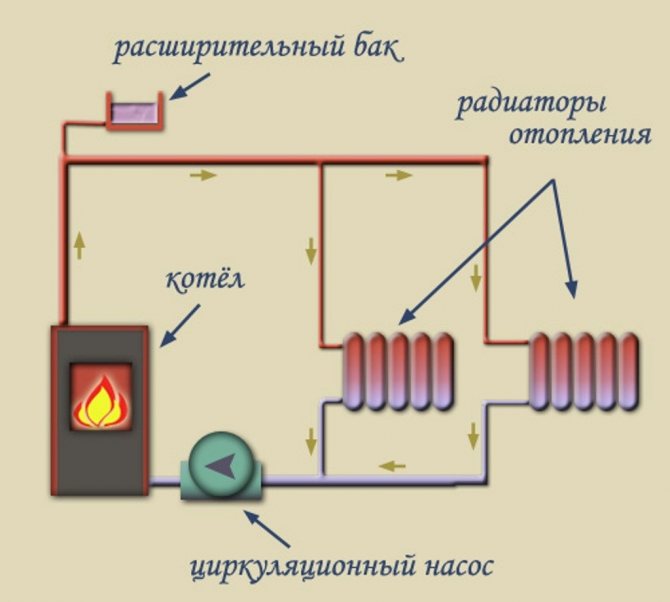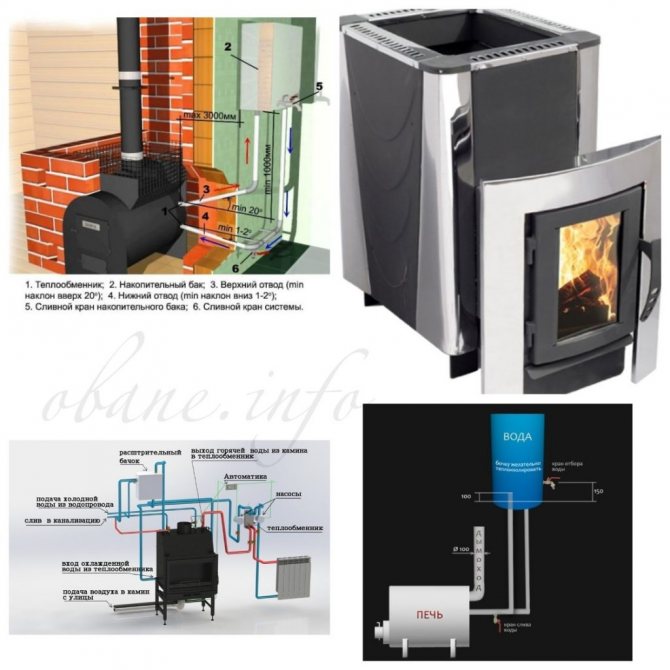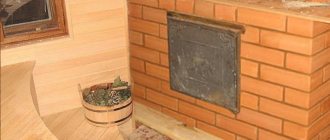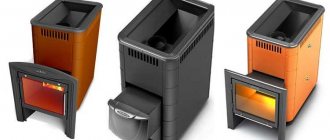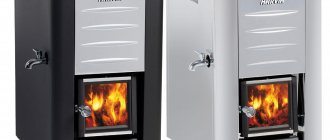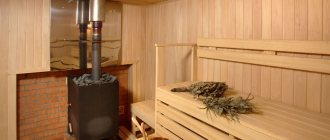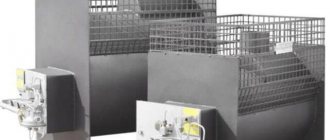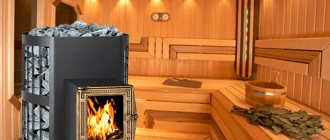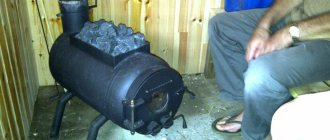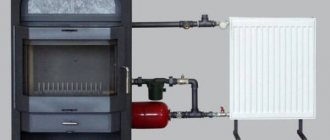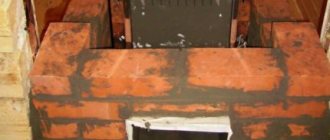Possible sauna heating options
Despite the fact that the options described above are the most popular and considered optimal, I decided to briefly mention some of the alternatives. In fact, they are types of oven heating, but they have their own characteristics.
For example, if you have such opportunities, then you can install a diesel boiler in your sauna. But for this option, a separate room is needed (diesel fuel does not smell weak), and you need to think about storing fuel.
There are also pyrolysis heating boilers. The undoubted advantage of such a boiler can be considered a very long, almost complete combustion of fuel. And the disadvantage is the high cost and complexity of operation (for example, raw wood does not burn in it).
It is also possible to use long-term combustion boilers capable of burning a separate batch of fuel for up to 5 days, maintaining the desired temperature. There are even options for high-quality high-quality coal. But this is rather an "industrial" option, which is not suitable for a good traditional bath.
Anecdote in the topic: Announcement on the doors of the housing office. Tomorrow at 12.00 for non-payment of utilities in your house, electricity, heating, cold and hot water will be cut off, windows and doors will be broken. Best regards, Administration.
This concludes my review of how to heat a bath. Which heating is better is up to you to decide, focusing on your needs and capabilities. The main thing is that the rooms are warm and comfortable. Thank you for reading to the end. Until next time, see you on the pages of other articles. Until!
Quote of Wisdom: There are no dark times, there are only gloomy people (Rolland Romain).
With the advent of modern sauna stoves, the problem of heating a room has turned from a purely technical problem into an economic problem. The owners of modern saunas and steam rooms, choosing a method of making heating in a bath, are forced to balance between efficiency and comfort.
The bath heating system is chosen based on its design and available energy sources. Today, there are four main methods of heating a room:
- Heating the bath from the sauna stove. Depending on the size, the internal space can be heated with boilers and wood-burning or gas-fired stoves;
- Use of additional electric convectors, installation of electric water boilers complete with radiators or underfloor heating systems;
- Equipment in the back room of the bath with an additional heating stove on wood, liquid or solid fuel;
- Connecting the bath to a heating plant or to the heating system of private housing construction.
It is clear that the choice of a suitable scheme is always done with the expectation of ensuring the required level of heating in the bath in winter. And it's not even about the low temperature in the dressing room or dressing room, the level of heating is directly related to air humidity and condensation.
For your information! The approximate level of heat load during maximum cold weather should be at least 1000 W / h per m2 of the steam room and 600 W / h per square of the dressing room and dressing room.
Most often, problems arise with wooden chopped buildings, heated by the heat of the brickwork of the heater. Therefore, before heating in a log bath, you need to think over the ventilation device in the steam room and the washing department.
Not only the system on wood and gas is used for a steam room or dressing room. Infrared equipment is gaining popularity today. No special permission is required to install it.
This system has a number of advantages:
- easy assembly / disassembly, which can be done by hand;
- small size;
- no need to purchase and add / report fuel;
- cost-effectiveness in comparison with electrical equipment;
- safety for people in the bath;
- short time interval for heating;
- low cost.
With the help of an infrared heater, you can even heat a compact sauna, which is now installed in large apartments.
Despite the large number of positive points, the use of infrared heaters also has disadvantages:
- With the help of a heater it is possible to heat up only a small area.
- It is impossible to simultaneously heat the bath and stones, which are often used for medical procedures.
- To heat a steam room, it will take from 4 to 6 appliances, which will cost the consumer a significant amount.
The provision of optimal temperature conditions in the steam room and other zones can be organized using a heating main - to start up heating from the house. For this, radiators are installed inside the structure (with the exception of the steam room). Another option is a warm water floor. It is safe and effective, but there is also a drawback - it is very difficult to implement, especially if the bath has already been built.
It is important to remember that heating the bath from the house can be organized only if the two structures are located at a short distance from each other or have a closed insulated passage (vestibule). This will reduce heat loss.
Self-arrangement of a warm floor
This option for heating a bath belongs to modern methods, which have been used often in recent years. It is rather difficult to install special equipment without relevant experience.
The base of the floor is preliminarily prepared, then the screed is poured using cement mortar. Next, the rough base is waterproofed using a special mastic. Then a thin layer of mortar is laid and carefully leveled.
When the mixture is completely dry, the heat-insulating material is mounted. Take a heating cable or mat and spread it over the floor surface, connect it to the power supply and test the functioning of the system.
In the event that the structure works, a thin layer of mortar is placed on top of the cable. After it dries, they proceed to the finishing of the floor surface.
In most cases, constant burning stoves are installed in the baths. which perfectly cope with the role of the main source of heat in the room. In this case, it is worth immediately making a reservation that it is advisable to use only peeled stones, the diameter of which reaches 10 centimeters, to equip the furnace. In order to reach the optimal temperature in the room, it takes at least two hours to melt such a stove, during which you will have to periodically throw up firewood.
The bathhouse is a wooden building with a high level of humidity in the premises. As you know, wood that is regularly exposed to water can deteriorate in a very short time. Because of this, unpleasant odors may appear in the bath, and the building itself will need to be repaired in the future.
To avoid this, you should decide in advance about its high-quality heating. At the same time, it is advisable not to be limited to only one stove, but to supplement it with various heating systems, which, moreover, will significantly reduce the period of heating the premises before taking water procedures.
For safety reasons, in such a humid room as a bathhouse, it is allowed to use one or two heating radiators, which must be connected to the heating system of a residential building.In addition, there are several other options for heating the bath, the choice of which depends only on your requirements and wishes.
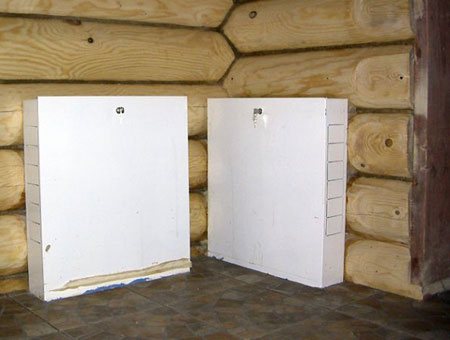
Heating radiators in the bath
In most cases, constant burning stoves are installed in baths, which do an excellent job of being the main source of heat in the room. In this case, it is worth immediately making a reservation that it is advisable to use only peeled stones, the diameter of which reaches 10 centimeters, to equip the furnace. In order to reach the optimal temperature in the room, it takes at least two hours to melt such a stove, during which you will have to periodically throw up firewood.
To avoid this, you should decide in advance about its high-quality heating. At the same time, it is advisable not to be limited to only one stove, but to supplement it with various heating systems, which, moreover, will significantly reduce the period of heating the premises before taking water procedures.
Stove air heating
Let us briefly consider this type of heating (warming up) a bath. In fact, this option is considered the most common and most convenient. It is ideal for small rooms used directly for bathing procedures.
A good heater can easily heat the entire bath, and at the same time it will not require the installation of an additional heat source and additional cash costs. Previously, to equip a good sauna stove, it was required to find a professional bricklayer or show a good imagination for its manufacture using improvised materials (what kind of stoves were not invented).
It's much easier now. You can easily purchase a ready-made product in almost any specialized store. At the same time, the installation of such heaters is quite simple and does not require any specific conditions. The only thing that you should pay special attention to when buying it is the power (usually indicated in the passport for the product).
This type of heating has one more positive side. Most stoves of this type are heated with wood, which forms a kind of psychological picture and allows true lovers of the bath to preserve the tradition laid down by our ancestors.
We suggest that you familiarize yourself with the Stone stove for a bath: this is good steam and a number of other indisputable advantages over other types of heating devices
By the way, the recently famous Teplodar company has released a new model of the fireplace stove called Siesta. She quickly gained prestige among her "bath brothers". And this is no coincidence, since it is heated from an adjacent room, thereby simultaneously heating both the steam room and the rest room. Agree, it's very convenient.
Naturally, there are options for heaters that use electricity, gas and even liquid fuel for heating. Well, here, I can tell you, everything is for an amateur and depending on your capabilities and preferences.
Organization of the water circuit using a boiler stove
Heating convectors are often powered by a variety of energy sources. This ensures a high level of reliability and ease of use. Thanks to them, you can create a completely autonomous heating system in the room. Today, electric convectors that are mounted on walls are very popular. They are ideal for small spaces.
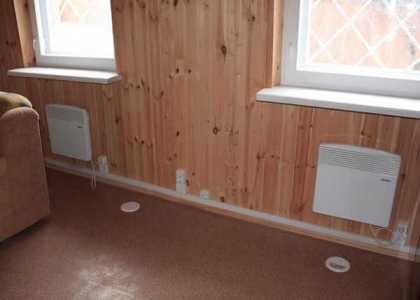

Heating in the sauna with convectors
A couple of decades ago, the provision of a comfortable thermal regime in the bath room was ensured by the accumulated heat of the brickwork on the back of the stove. The loading tunnel of the combustion chamber was taken out into the dressing room, and the furnace itself was built into the partition in such a way that the rear brickwork was divided in equal parts between the recreation room, the dressing room and the washing compartment.
In modern baths, brick ovens are built of much more modest sizes, therefore, more efficient cheap designs are widely used for heating the room:
- Water heating from a gas or wood-fired sauna boiler;
- Built-in heating from a heat exchanger or a tank installed on the main stove of the bath;
- Boiler heating using a heat accumulator connected to a sauna stove.
In addition, in baths made of adobe blocks, adobe and adobe bricks, heating is often used with the help of hot air flowing through the stove registers through clay channels in the walls and the subfield of the room. The method is incredibly reliable and easy to operate, but it requires highly skilled craftsmen. It is used mainly in dry continental climates.
The simplest heating option involves the use of a special boiler model with a built-in water circulation circuit. To organize heating, it is enough:
- Install and connect the expansion tank, pipes and pump to the water circuit;
- Hang aluminum radiators in the dressing room and the washing compartment.
It is clear that before doing heating in the bath from the stove, you will need to perform a simple calculation of heat transfer in each of the rooms. If the boiler is gas, then set the comfortable air temperature in the changing room or in the washing compartment. Combustion automation is capable of maintaining the temperature in the water circuit with an accuracy of one degree.
For your information! The main advantage of boilers with a built-in additional circuit of a water jacket is an unlimited amount of hot water, which can be obtained for the needs of a house, a summer residence or a summer kitchen.
It's another matter if a boiler-stove with a water circuit runs on wood or pellets. In this case, even the installation of an additional tank does not save, in order to adjust the operation of water heating, you have to use a pump with a variable water supply capacity or install bimetallic thermostats on the radiators.
A few tips from professionals
- To ensure optimal and efficient heating of the room, the heating of the bath from the stove in the steam room is done as follows: the firebox is placed in the dressing room, the heater is in the steam room, and the tank with warm water is in the washing compartment.
- A non-combustible material is placed between the stove and the wall, and when using firewood as fuel, a metal sheet of the required size is placed in front of the door.
- When a steel stove is purchased, then the room will warm up quickly, but to maintain the required temperature, you need to constantly put firewood in the firebox, since it does not store thermal energy well.
- Stone stoves, despite the fact that they warm up for a long time, remain hot for a long time and gradually release heat into the room. Such a heating structure made of bricks should be laid out by a master. If a metal stove heats up a room in about 2 hours, then a stone one - in 5 hours.
- When a residential building has a small area and is located near a bathhouse, then a bath stove can be used to heat a house, for example, a summer cottage.
The choice of fuel often depends on the individual wishes of the owner of the building. Some of them prefer firewood, because there is a pleasant aroma in the steam room during their combustion, but one must not forget that the heating of the stove with their help is a laborious process. It may be easier to install an electric or gas heating unit.
We are heated by the oven
A water bath boiler is quite expensive, while the built-in heating circuit does not particularly affect the operation of the steam room, and it is used in the bath mainly in the cold season. From this point of view, the purchase and installation of a heating system for a bath looks economically unjustified, especially in a situation when the bath room has only a steam room and a dressing room.
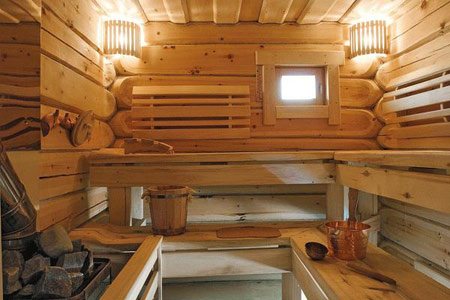

In addition to the boiler method of heating water, the steam room most often has a second source of boiling water - a manual or hinged tank, in which the liquid is heated to spray the backfill of the heater. Typically, 50 to 100 liters of water are boiled in such a tank. Is it possible to heat a bath from a tank?
A simple calculation shows that in a tank with a capacity of 100 liters, filled to the top with boiling water, heat is stored in the equivalent of 8-10 MJ or 2.5-3 kW / h. If you use at least 80% of the energy, then this will be enough to organize the heating of the dressing room from the sauna stove.
The heating system of the bath can be almost doubled if, instead of a control tank for heating, a system with a heat exchanger built into the stove is used. You can remove heat from the stove in a variety of ways:
- Install a system of tubular registers made of steel pipes in a brick stove;
- Install a copper or alloy steel coil in the firebox;
- Use a double tank structure as the walls of the combustion chamber.
To ensure effective heating of the bath, the size of the furnace chamber will need to be selected based on the increased performance. Usually, a firebox for a stove with a water circuit is chosen for a single load of at least 2.5 kg of firewood.
A relatively new method of heating living rooms in private houses using heat accumulators is also gaining popularity for heating a bath. Moreover, a huge tank with an alkali solution or paraffin melt is most often installed either in the basement of a building or in the nearest outbuilding. The bath is best suited for these purposes.
The heat accumulator is heated either by excess heat in a stove or solar collector, or by electric heating at night. In this case, due to the reduced electricity tariff, heating costs are reduced several times, especially. if the bathhouse is located next to the house. An even higher level of savings can be obtained if you solve the problem of how to heat the bath from home.
The implementation of such a heating system has several options.
- Firstly, as I wrote above, it is possible to install a "classic" heater, in which a gas burner will be used instead of firewood.
- Secondly, you can use a standard gas boiler (the same as in residential buildings). But in this case, you will have to take care of the equipment of heating systems (installation of heating radiators, laying pipes, bringing a gas-carrying pipe to the bath or a system for connecting to a cylinder).
- Thirdly, there is the possibility of heating from home. In fact, this is the same option as the previous one, but with its own characteristics and disadvantages. A separate heating main is laid from the boiler used to heat the house to the bathhouse. This option is very convenient if your steam room is adjacent to the house or is very close to it.
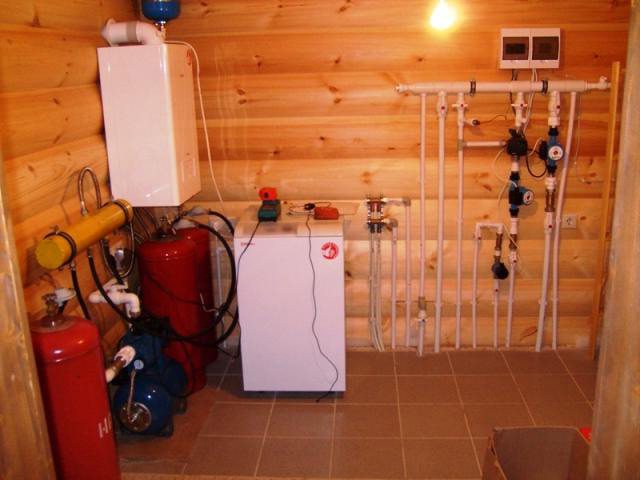

Bath gas heating
If the distance to the bath is relatively large, then in order to use this system in winter, it is necessary to deepen the heating main below the freezing level of the soil and insulate it well. This will prevent it from defrosting and help reduce heat loss.
We offer you to familiarize yourself with a gazebo with a bath under one roof: the best projects for a summer residence
True, the undoubted advantage of this option is the complete elimination of the problem of maintaining a constant positive temperature in the bath room. In addition, you can do all the necessary work (if you have a certain skill) with your own hands.
The opinion that the time of the Russian stove has passed is erroneous. The wood-fired stove, familiar to many, continues to be popular. In general, its advantages can be formulated as follows:
- simple operation;
- the ability to do it yourself;
- work on one of the available types of fuel - wood.
Going through the options and giving preference to the Russian stove, we must not forget about the disadvantages:
- the bulkiness of the oven;
- the heating process is not subject to automation;
- high probability of fire;
- wood-burning stoves are a source of dirt.
An analogue of the familiar Russian stove is the so-called potbelly stove. This stove also runs on wood, but it is compact in size.
In addition, if the "potbelly stove" is made by hand, its use is very dangerous.
Water heating is becoming more and more popular today. This is facilitated by the large selection of equipment that can be used. It should be remembered that this type of heating in the bath should be arranged so that in the warm season it can be turned off, leaving the heat exchanger to work only to heat the water. That is, you need to purchase a boiler with two circuits.
It is carried out using three types of fuel:
- Strip. To organize gas heating, it is imperative to connect to a common gas supply system. You will also need special equipment through which the fuel will flow. There are a large number of settlements on the territory of our country that are still not provided with gas. An alternative type of fuel - liquefied or bottled gas - has an increased degree of fire hazard.
- Electricity. In order for electrical heating to provide a comfortable room temperature, it is important to accurately select the power of the equipment. Due to the complexity of these calculations, it is not recommended to purchase and install an electric boiler with your own hands. Unlike gas heating, the use of electricity does not require the installation of a chimney. The disadvantage is the high cost of electric boilers, as well as the complexity of the technical process.
- Firewood. The wood-fired system allows you to warm up the room relatively quickly. In general, heating a steam room in a private house with wood-fired equipment is traditional. But many people do not like the complexity of the process of preparing fuel and kindling the furnace.
What equipment is required for this
In general, a variety of equipment can be used to provide heating for the bath in winter. Some users prefer hot water heating. Radiators or underfloor heating can be connected to a heating plant or a heating system from the house. However, there is a definite disadvantage here. If you do not live in a country house all the time, the water in the pipes will simply freeze, breaking them, since the heating plant may stop working for several days for some reason. As a result, you will have to spend a lot of money and time to eliminate the consequences of such a breakdown.
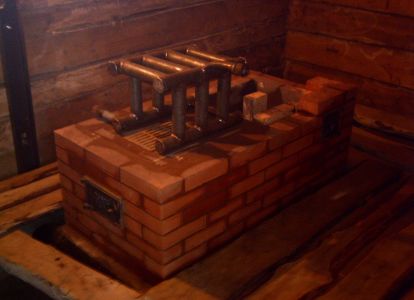

Sauna stove with water heater
Many people prefer electric heating devices. Their main advantage is ease of use. No need to spend money on installation and disassembly of a ready-made bath. You can bring one or two electric heaters to the dressing room at any time and turn them on half an hour or an hour before the gathering.
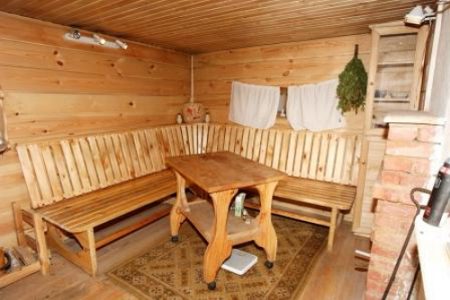

But here, too, there is a certain disadvantage. Most often, the humidity in the dressing rooms is quite high, especially if it is located across the wall from the steam room, and the door is opened and closed regularly. Electrical appliances do not work well in high humidity conditions - there is a high probability of breakdown. And being left without a heater before meeting friends on cold winter days is not a very pleasant surprise.
Electric sauna heater
Therefore, electric underfloor heating remains one of the best solutions. Yes, during installation you will have to spend a fairly large amount - such work should be performed only by specialists if you do not have the appropriate skills. But in this case, you do not have to fear breakdown and some other unpleasant consequences.
Electric cables are reliably protected from moisture, which means they will not be damaged even when working in difficult conditions. They are also not afraid of temperature drops.Even if you leave the cottage for several weeks or months, it is enough to turn off the warm floors - nothing will harm them. But when you are going to the bathhouse, then 3-4 hours before the water procedures, it is enough to turn on the heating system. During this time, the temperature in the dressing room will rise to such a level that you and your guests will feel comfortable even after a hot steam room.
Floor heating device diagram
The possibilities of electric underfloor heating are not limited to this. Some bathhouse owners decide to install a heating system, both in the bathhouse itself and outside it. First of all, this is the porch. Many connoisseurs of baths are familiar with the problem of porch icing. There may be accidentally spilled water if you carry it into the bath by hand.
But this can be avoided if, when installing the underfloor heating system, you order two circuits: one, large, for heating the dressing room, and the second, small, for heating the porch. In this case, the water will never freeze on the porch, but will drain from it or gradually evaporate. Anyway, the ice problem will be solved.
Heating a bath with a fireplace
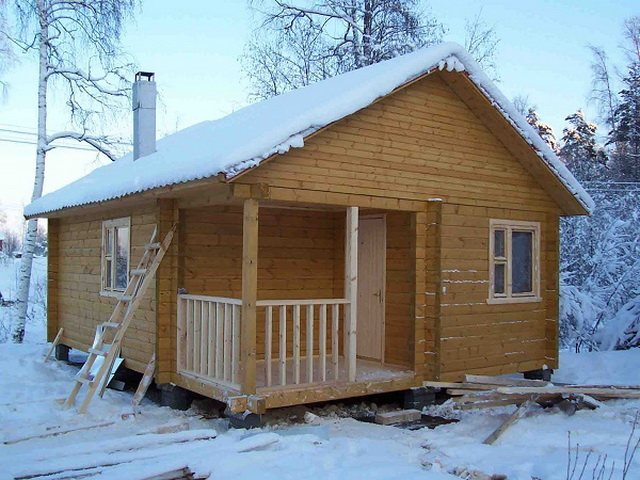

The use of a fireplace stove is considered one of the most effective ways to heat a small sauna room in the country or in a guest house. In this case, the sauna stove consists of two parts:
- Brick stove-heater with a combustion chamber, which is loaded with wood from the steam room;
- Fireplace facade, attached to the stove and overlooking the dressing room or dressing room.
The fireplace and the stove are combined into one brick structure; moreover, their chimneys are connected in one chimney. The large weight of a brick oven does not affect the quality of heating in any way.
Important! The fireplace should be heated first, and only after warming up the chimney can a fire be started in the heater's furnace. Otherwise, the fumes from the fireplace will burn out in the steam room.
Heating a bath with convectors
One of the most convenient and effective heating methods is rightfully considered to be the arrangement of water heating. In a similar situation, there are also several options for manufacturing a system that in any case will be powered from a furnace with a water circuit.
Fortunately, today in specialized stores you can easily pick up ovens ready for installation, complete with a heat exchanger. This greatly facilitates the task of any builder of his own bath. And now directly about the options.
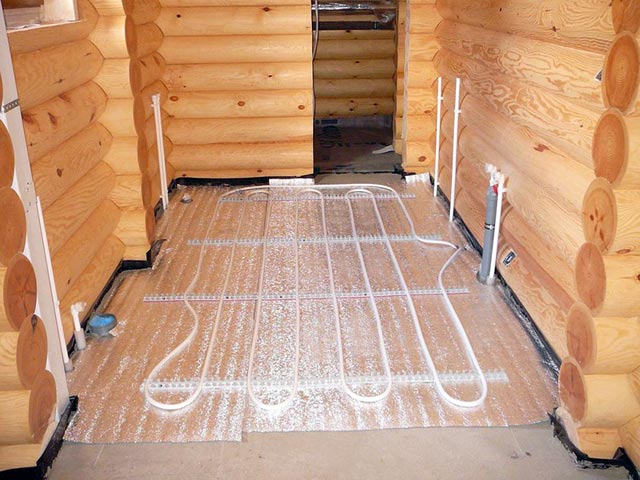

Water heated floors
- External heating. It is done very simply and, in fact, equips itself in the same way as the brownie. Pipes located along the walls are connected to the furnace. A certain number of heating radiators are connected to the pipes, depending on the area of your bath. Hot water, passing through them, heats up the structure and, cooling down, returns back to the boiler.
- Water heated floor. Its principle of operation is the same as in the first version. The only difference is that the pipes are hidden in the floor, which was previously insulated (I wrote about the insulation of floors in the bath in more detail in other articles). Such a design is considered non-separable (although, of course, there would be a desire to break everything down), and therefore requires a very careful approach to the procedure for its manufacture. In this case, I would recommend seeking help from specialists.
Sauna electric heating
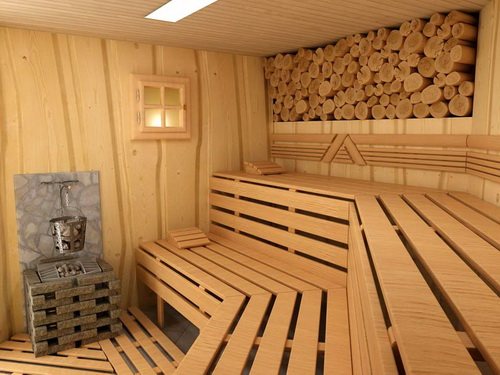

And finally, let's look at several ways to use electricity to heat a bath. I must say right away: take care of the electrician in this case. Since the load on thermal electrical appliances is large, the quality of the wiring should not be in doubt. Consider the total load, wire size, wiring diagram and the quality of the wiring work.
Electric heating
Firstly, your room can be heated with an electric heater.True, in this case, you will have to take care of heating the water in the shower in advance (for example, by installing a direct or indirect heating boiler). This type of heater does not require additional arrangement of the chimney and is considered environmentally friendly.
We offer you to familiarize yourself with Honey in a bath and a sauna: how to use, which one to choose
Secondly, the sauna room (in particular the rest room) can be heated using electric convectors placed on the walls.
And, thirdly, infrared film can come to your aid - the newest type of heater, which allows you to quickly and easily make warm floors both in the house and in the sauna. Detailed technology for installing a warm floor is discussed in other articles.
It is quite possible to use infrared heaters as an additional source of heat. I hung it on the ceiling and forgot.
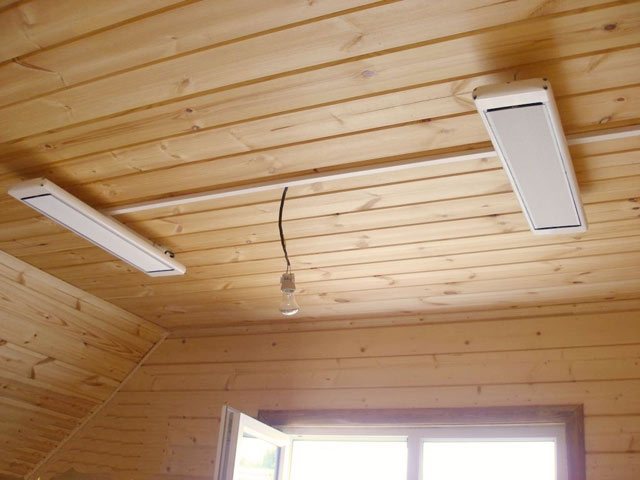

Infrared heaters
The use of electricity for heating the bath undoubtedly has its advantages. You can safely use all structural elements (heater, heated floor, boiler) at any time all year round. In this case, you do not have to worry about fuel and fear for freezing pipes. The only serious drawback is the high power consumption.
The use of electricity to heat bath apartments is considered to be the most unprofitable heating method. Despite the fact that the technical part of the question - the purchase and installation of two or three heaters costs mere pennies, the energy consumption for heating the dressing room and the rest room using electric convectors is quite expensive.
It is considered even more unprofitable and unsafe to heat the bath room with the help of infrared emitters. According to the owners, such a device can be hung in the vestibule of the bath above the front door; it is economically unprofitable to heat the entire room with it.
The only economically viable way to heat a room with electricity is to use an electrode electric boiler with aluminum radiators or equipment in the room with a warm floor. In this case, the cost of paying for consumed electricity is comparable to gas heating.
Don't forget about safety
But in the steam room itself, it is undesirable to install electric underfloor heating. Yes, it will make the trip to the sauna more comfortable. After all, true connoisseurs of a bath know that it is the floors, especially in winter, that can remain cool even after many hours of heating. All the heat rises, and near the ceiling the temperature can go up to 70-80 degrees, but the floors will remain cool. When using electric underfloor heating, this will definitely not happen - they will heat up much faster than a bath is heated.
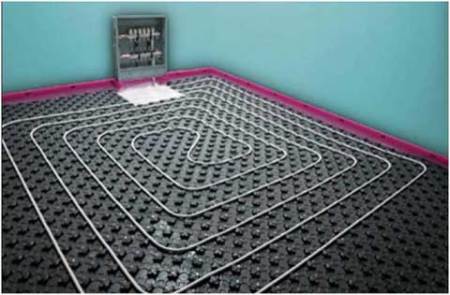

But do not forget that in the steam room, liters of water are spilled on the floor every minute. And water and electricity are poorly compatible. Of course, the electrical cable is mounted in a concrete screed, on top of which boards are laid. Yes, the cable is supplied with all the necessary insulation to guarantee maximum safety.
In this state of affairs, an unfortunate set of circumstances is enough for you, your loved ones or guests to receive an electric shock. How can this end? The consequences can be the most dire. Therefore, despite all the persuasions of specialists, you should not install warm floors in the steam room, at least electric ones.
Moreover, not all visitors to the bath are equally well tolerated. And the bathhouse, in addition to the laws of physics, seems to specifically provide for such an option. People who love steam and heat can sit on the top shelf, and those who just went out for the company or have heart or blood pressure problems can sit on the shelf below - they will feel more comfortable there.
Mixed
In the case when you do not often use the bathhouse (especially in winter, rarely arriving at the dacha), then a mixed heating device will be the best option.For example, a stove is installed and electric heating is done. Decided to take a shower, relax or “stretch” - use electricity. We decided to take a steam bath "in an adult way" - heat the stove thoroughly.
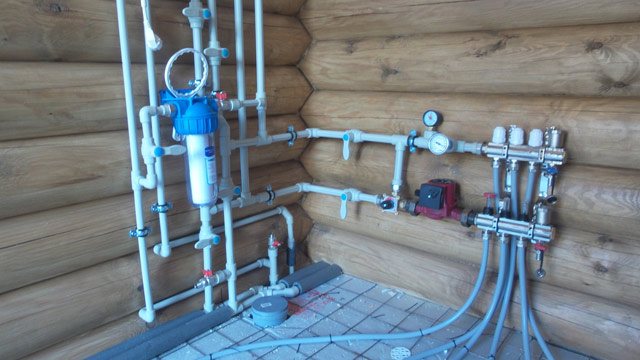

Underfloor heating control unit
Material selection
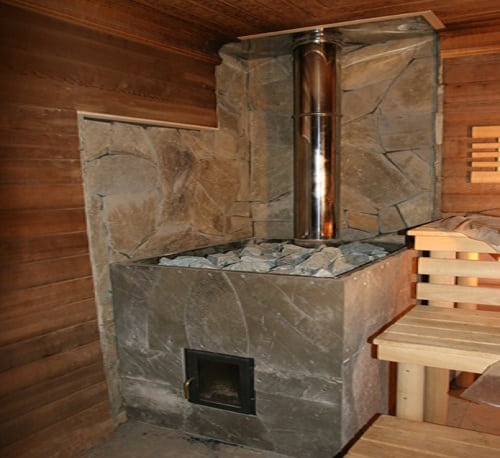

Think in advance about all the materials that you will use in the construction, they should in no case be flammable. Also arrange for the necessary room ventilation... There are many materials recommended for the device of the furnace, but the most popular are brick and steel.

